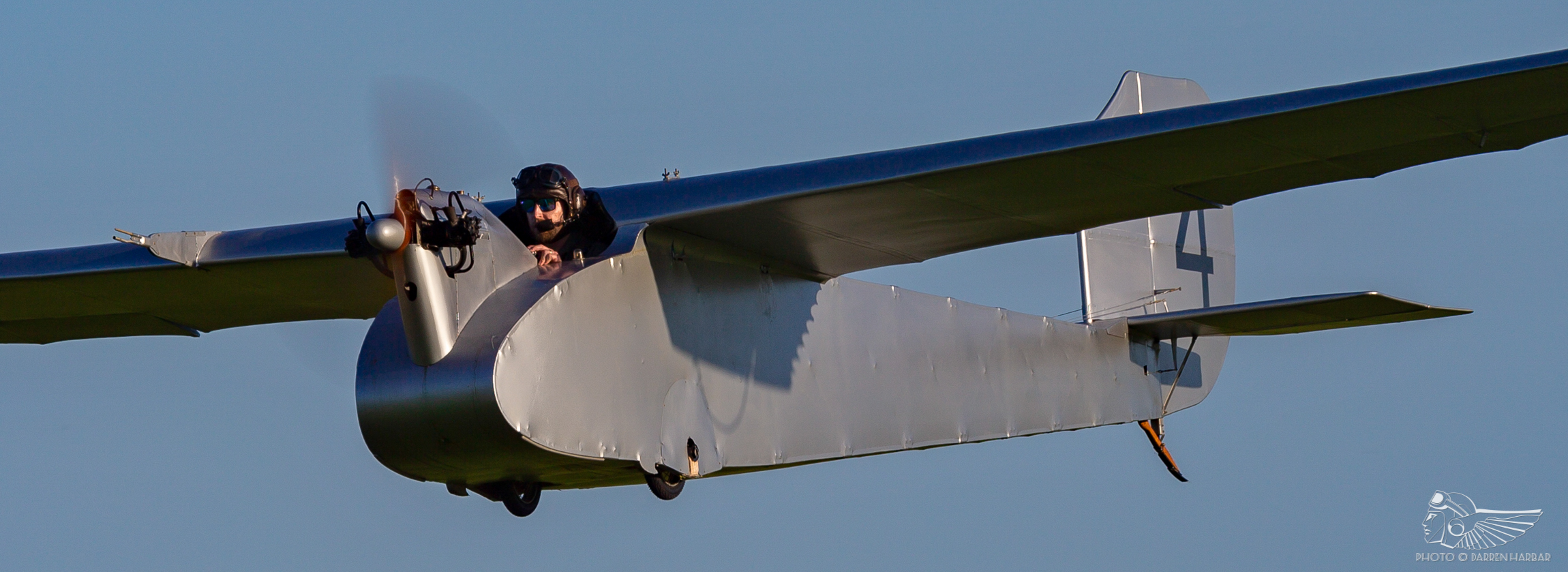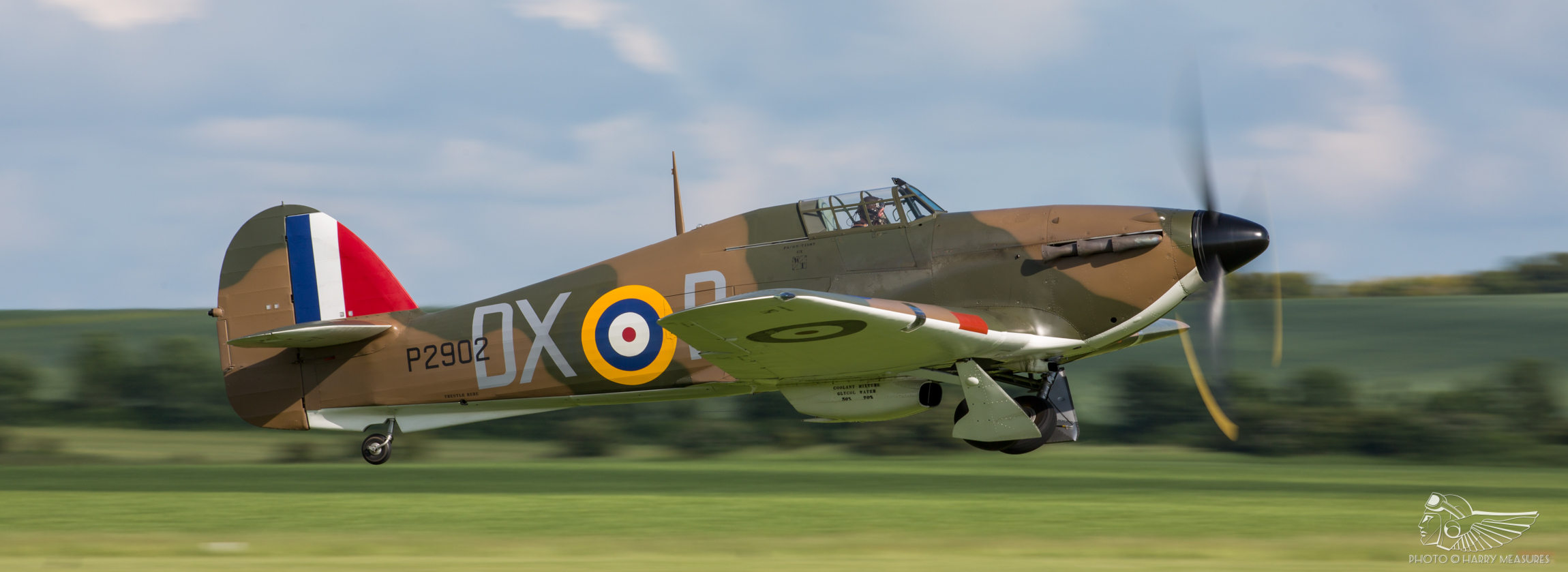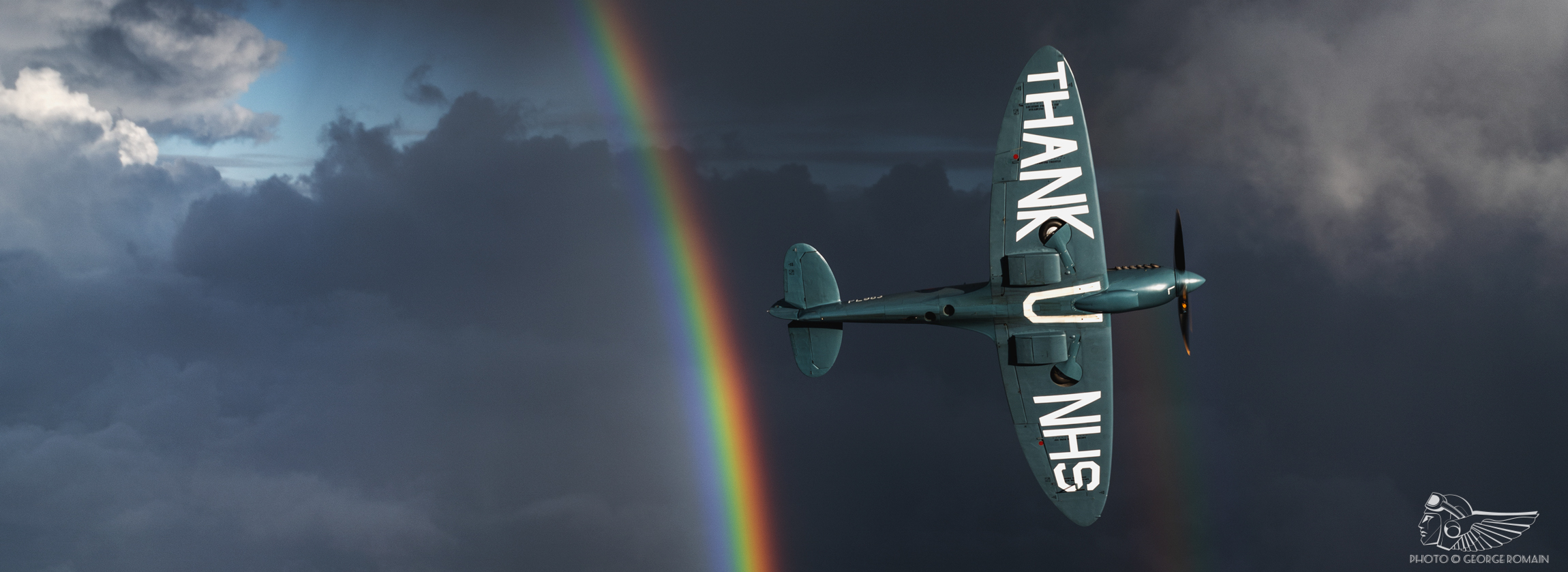“As a pilot, you’re very aware of the aeroplane’s history and provenance, and the significance of where you’re flying it”, says Richard Crockett. “It means something to people.”
We’re stood beside the Wren, English Electric’s attempt at designing an economical single-seat ultralight. Just three were built, and only this one survives. It still flies at Old Warden in Bedfordshire as part of the Shuttleworth Collection, achieving heady airspeeds of 45 mph and spending most of its time below 100 feet.
The Wren was manufactured in response to the Air Ministry’s call for a light training aeroplane, and W.O. Manning’s predominantly wood and fabric design consequently shared many qualities with successful gliders of the era. To reduce drag, the narrow track undercarriage was partially submerged in a tapered fuselage little broader than the average pilot at its widest point, while the open cockpit was buried in the fuselage aft of the engine nacelle. Suitable aero engines were a limiting factor for light aircraft, and so the Wren was mated with a converted 398cc 3hp ABC twin cylinder engine of the type used in motorcycles and household appliances, which drove a two-blade fixed pitch wooden propeller.
Carrying the Royal Air Force serial J6973, the Wren made its first tentative hops at Ashton Park, Preston, lifting only a few inches off the ground. The aeroplane was moved to the expanse of Lytham sands for more trial flights, and on 8 April 1923 Sqn Ldr Maurice Wright carried out a successful seven-minute flight, getting airborne in 50 yards and climbing to 300ft at 40 mph. Later he flew the Wren for over an hour at full throttle, achieving level airspeed of 52 mph and burning less than a gallon of fuel. With a proposed unit cost of £350, the Wren was positioned to compete against the contemporary training aeroplanes that were on the market for more than three times that cost.
Two more Wrens were manufactured in 1923 and entered into the Daily Mail lightplane competition at Lympne, Kent that sought to find an economical aircraft design that would meet the post-war public demand for affordable pilot training and recreational flying. More than a dozen types were entered into the competition, most of them powered by modified motorcycle engines.
There the Wrens were flown by Sqn Ldr Wright and Flt Lt Walter Longton respectively throughout a series of speed, height and fuel consumption trials in early October 1923. Significant prize money totalling £1,500 was offered by the Duke of Sutherland (then the Under-Secretary of State for Air) and the Daily Mail for the farthest flight exceeding 50 miles on one gallon of fuel, which would be conducted over a triangular 12.5 mile course. Preliminary flying trials on 8 October saw Wright, flying the Wren marked ‘No. 3’, manage almost 72 miles per gallon (mpg). Longton, meanwhile, recorded a more impressive 85.9 mpg in ‘No. 4’, but failed to reach the standard set by ‘Jimmy’ James in the ANEC I.
Longton’s flight on 11 October was more successful, the Wren this time equalling the ANEC’s 87.5 mpg figure. As joint winners, the Duke of Sutherland’s £500 prize and the Daily Mail‘s £1,000 award were shared between Longton and James. To celebrate the end of the competition, Longton took off in the Wren at sunset and flew his Hendon Pageant ‘crazy flying’ routine for the remaining onlookers.
Wren No. 3 was subsequently registered G-EBNV to Alan Smith and went into storage in Bradford in 1929, passing eventually to R.H. Grant of Dumfries. Meantime, Longton’s Wren No. 4 joined the Science Museum in London. For more than two decades it hung in the aeronautical gallery, flanked by Alcock and Brown’s Vickers Vimy, finally returning to English Electric and disappearing into storage at Strand Road, Preston, in 1946. The No. 3 Wren’s remains emerged from a farm in Dumfries in the early 1950s and were offered to the Shuttleworth Trust, but most of the airframe was beyond repair. Nevertheless, a team of wood and fabric workers formerly of English Electric’s Vampire production team (EE having manufactured the majority of de Havilland Vampires), led by test pilot Peter Hillwood and development engineer Bill Eaves, undertook to rebuild the aeroplane to airworthy condition, supervised by its original designer, the then 80-year old W. O. Manning, amalgamating parts from both Wrens and incorporating new structure and components.
Engine runs suggested the overhauled ABC engine was suffering from low compression and reduced power output, but the team persevered. The Wren returned to flight on 25 September 1956, taking No. 3’s registration of G-EBNV but retaining No. 4’s tail number, and was flown by both Hillwood and Roland Beamont, then flight operations manager and chief test pilot, over the winter of 1956-57. The 12-stone, 6’5” Hillwood was initially limited to hopping the Wren along Warton’s runway, but several flights to 300ft or so followed.
Though poor power output hampered the first flights, fine tuning of the engine and fitment of a coarser propeller saw the Wren climbing to 1,200ft. Almost a year after its first post-restoration flight, Wren G-EBNV was donated to the Shuttleworth Collection during the Royal Aeronautical Society’s Garden Party at Wisley on 15 September 1957. To celebrate the occasion, the aeroplane flew for eight minutes in front of an audience that included W. O. Manning and Dorothy Shuttleworth.
The “diminutive” Delphine Grey Fiske was reportedly the only pilot who was able to climb to sufficient height to demonstrate the Wren effectively at public displays during the late-1950s. Engine overhaul by Wally Berry in 1975 restored the ABC to 2,500 rpm and enabled Desmond Penrose to climb the Wren to circuit height for flight demonstrations. In Penrose’s hands, the Wren achieved a maximum level airspeed of 40 mph, with stall buffet noted at 24 mph and airspeed reaching 70 mph in a shallow dive with no notable degradation in the controls.
It remained a popular fixture at Old Warden for the next 40 years, albeit one eventually limited to short hops as degraded engine output curtailed its circuit flying ability. Particularly enjoyable were the bungee assisted launches, courtesy of a dozen-strong ground crew complement. Yet despite its longevity at the Collection, the Wren could elude even regular visitors to Old Warden, and strict operating parameters limited flying appearances to calm days with wind speed not exceeding 10 mph and a minimal crosswind component.
Eventually overhaul beckoned. In 2017 the Wren was moved into Shuttleworth’s engineering workshop where its fabric covering was removed. Once re-covered with Dacron, a lightweight fabric furnished with as few coats of dope as practicable, the Wren was a significant 40Ibs lighter.
Work on the engine over winter 2018 to ’19 yielded marked improvement in performance. Fitment of a newly fabricated double skinned induction manifold manufactured by Dave Scott was key to this. The ABC’s exhaust piping runs through a fabricated metal structure encasing the inlet tract, which pre-warms the incoming fuel mixture to prevent carburettor icing. The old manifold had corroded to the extent that exhaust gasses were escaping the piping, contaminating the mixture and curtailing the engine’s output.
The overhaul concluded in early 2019 and the Wren returned to flight during Shuttleworth’s spring warm-up. The work paid dividends, and in the hands of ‘Willy’ Hackett and ‘Dodge’ Bailey the Wren flew its first circuits in several decades. For most, it was the first time they’d seen the aeroplane flying more than a short hop.
Richard Crockett is the third Shuttleworth pilot to fly the Wren post-overhaul. For the last eight years he’s held the post of Chief Flying Instructor and Head of Training at Booker Gliding Club, and since 2016 he’s flown Shuttleworth’s light taildraggers and vintage gliders. That wealth of gliding experience put him in good stead to approach the Wren, fundamentally an ultralight motorglider, for the first time in spring 2021. “We get a Collection newsletter at the start of the season, and in that the Chief Pilot writes who’ll be flying what”, he remembers. “I’d been down to fly the Wren for quite a while, but you know what this place is like – the weather conditions aren’t always right, and you need near perfect weather to fly an aeroplane like this.
“When I first approached it, I was quite intimidated because it’s marginal at all times and I was worried about getting it right as there is a technique to getting it airborne – a coaxing process, rather than just yanking it off the ground. When I first flew it, Stoney [ Shuttleworth’s Chief Pilot Paul Stone – Ed.] told me to just do a hop, turn around and hop the other way, and I did. The next time I was going to fly it was in an air display [Shuttleworth’s Flying Festival of Britain, early June 2021 – Ed.]. I couldn’t get airborne at all on the first run, and just about got off the ground on the return run.
“Weight is everything. Willy and Dodge have a major advantage in being significantly lighter than I am, Dodge probably by ten kilos. That forced me to do something about it – go and have a long think about getting the elevator attitude right and not trying to force it off the ground early, but mainly lose some pounds!”
That he did – Crockett’s “mega diet” and exercise regime shed him more than a stone (14 lbs) in four weeks. The diligence paid off – the next time he was rostered to fly the Wren, the aeroplane got airborne first time and he was able to perform a series of climbs and turns in a true demonstration of the Wren’s flying abilities. “Just magic”, he says of that flight at Shuttleworth’s Flying for Fun evening airshow in mid-July 2021. “I wasn’t concerned about the handling as I’d been assured it was very nice. Getting it off the ground and getting the best out of the engine were the concerns, particularly as it’s very, very marginal. To finally fly it was truly incredible and such an amazing privilege.”
The conversation recounted in this article followed Richard’s third flight in the aircraft. It’s Old Warden’s Vintage Airshow in early September 2021, and he spends our time beside the Wren describing the aeroplane’s charming anachronisms with almost rhapsodic enthusiasm. “You could say I’ve fallen in love with it. That’s a clichéd thing to say, but I have a real fondness for it. It has a lot of quirks and some significant challenges, but once you get your head around that and know how to get the best out of it, it’s truly lovely.
“The first challenge before going flying is getting yourself over the side without putting your foot through the fabric”, he laughs. There’s an art to it, he says – a knot of limbs that few spectators see on an airshow day. “You’ve got to lift your leg up high over the cockpit coaming and get one foot onto the seat. You’ve then got to use this odd method of lowering yourself sideways, pushing one leg into the opening, bending the other leg and then twisting your body straight whilst pushing both legs into the fuselage beneath the fuel tank. You can’t see your feet once they’re in so you need to make sure you’re stood on bits that can take the weight – you could easily slip off the side and go through the fabric below. Once you’re in, your arms are still above the cockpit coaming and one at a time you need to bring them in. There’s loads of space below the shoulders – it’s cavernous. It’d be a nice soaring glider as there are places to keep your sandwiches and that sort of thing!”
The pilot sits in the nose of the aeroplane immediately aft of the engine and with his head sitting level with the wing leading edge, a vantage point that provides a terrific field of vision in all directions. In the pylon fairing between the engine and cockpit are mounted a one-gallon fuel tank and an oil tank with a one-pint capacity. A two-position push-pull selector cock beneath the instrument panel operates the basic gravity feed fuel system, whilst the pilot controls the oil system in-flight by manipulating a spring plunger and ‘T’ handle mounted under the port cockpit coaming. The oil system is pressurised by pushing the handle in against spring pressure, and oil flows to the engine as the handle returns to idle position over the next 20 seconds. For the pilot, that means keeping a weather eye on the plunger and repeatedly pushing this back in to keep the oil system pressurised in-flight.
The rate of oil flow to the engine is governed by anticlockwise rotation of the small ‘T’ handle that adjusts the needle valve through which oil is delivered to the engine. Too little oil can cause overheating, while too much can foul the plugs and cause a mag drop – hence it’s critical to maintain 1 ½ drips per second (d/s) at full throttle in-flight. The pilot monitors the drip rate through an inverted ‘J’ tube within a sight-glass fitted on the top of the fuselage in front of the ‘T’ handle.
Engine controls are equally antiquated but fall to hand easily enough. The throttle lever is of push-pull variety and is mounted at the base of the pylon directly in front of the pilot, and a butterfly nut at the bottom of the lever adjusts the throttle friction. Engine timing is controlled by an Advance and Retard lever on the starboard cockpit wall, with timing increased by moving the lever up from RET to ADV. A single magneto switch sitting beside the throttle lever at the base of the pylon provides ignition control. Flying and engine instrumentation is spartan, consisting of a trio of gauges – airspeed indicator (mph), altimeter and engine rev-counter – ingeniously stacked vertically on the rear sloping edge of the engine nacelle. Neither fuel nor oil tanks are gauged.
Unique to the Wren is the take-off attitude check that precedes the starting procedure. “The stick sits all the way forwards, so it’s about understanding where the neutral elevator point is”, says Richard. “That point is slightly back from vertical but finding that exact point is critical – it needs to be dead level to accelerate to take-off airspeed, otherwise you’ll just be inducing drag and you won’t get airborne. I get the ground crew to turn the aeroplane so it’s pointing in take-off direction and then lift the tail so I can gauge a reference point for that attitude – a hedge, for example – and to use the petrol cap to position the horizon, taking into account the fact that the airfield slopes a bit.
“It’s as accurate as saying the top of the hedge should be on the nut and the bottom of the hedge should be level with the top of the cap. Willy’s got a book with notes on all the aircraft he’s flown. He’s drawn a picture of where the hedge should be in relation to the top of the engine and I’ll be doing the same thing. I repeat that drill with the ground crew ten minutes later. It’s vital to revisit that angle each time you fly, as your points of reference may have changed – the hedge may have grown!”
As with all aeroplanes of the Wren’s vintage, application of the correct hand starting procedure is critical. The engineer leads the sequence.
‘Fuel on, throttle closed, switch off’.
The pilot responds with the affirmative, signalling for the engineer to prime the cylinders directly through the exhausts and pull the propeller through.
‘Ready for starting’.
The fuel cock is pushed fully forward into the ON position, the plunger is unclipped and pushed in to pressurise the oil system and the ‘T’ handle to the right of the plunger turned anticlockwise by half a turn to increase the oil flow to 1 d/s. The Advance/Retard lever is set to around a quarter of its travel, and the throttle cracked.
‘Contact’ – the pilot switches on the single magneto and the engineer swings the propeller.
When the engine fires, the pilot is immediately looking at the sight-glass and adjusting the ‘T’ handle to achieve consistent oil flow of 1 to 1 ½ d/s, at which point the Advance/Retard is opened fully to ADV and the controls checked for full and free movement. The rpm settles initially at 1,600, then is increased until the engine runs smoothly after a couple of minutes, preceding a run-up to 2,400 rpm.
“Throughout the run-up, I’ll keep looking at the engineers. They know the engines inside out, and they’ll hear if you need to make any adjustments. Pilots are OK at stick and rudder stuff, but when it comes to knowing about these engines, the engineers are an encyclopaedia of invaluable knowledge. There’s no way your average pilot could get an aircraft like this started without their input. Rory [Cook] seems to help me out every time; the Wren’s his baby. The engineers have looked after these aircraft for decades in many cases. They’re very much their babies, not ours.
“You start to the side of the runway and are wing-walked to the runway centreline. The Wren steers beautifully by itself. It has a barn door of a rudder that makes it feel like it has a steerable tail wheel. At the start of the take-off run, you open the throttle to full power. The volunteers run with you for ages to give you that extra bit of ‘oomph’. Your complete focus is to get that perfect take-off attitude. Once you achieve that, you’ll accelerate a bit more and you’ll get a sense of energy building slowly.
“As it accelerates, roll control becomes effective in the 15 to 20 mph range. It’s like a glider in the sense that you need to keep the wings level and correct any minor wing drop, particularly if there’s any hint of a crosswind. You can’t see them in your peripheral, but you can feel the lateral attitude and that’s where a gliding background is useful.
“You have to recognise the fact that it’s going to take a long time. If you’re being hasty, you end up pulling the stick back to try and get it off the ground and all that does is create drag.” Just a little too much forward or back stick pressure induces drag, and excess back stick pressure will dig the tail skid into the grass and arrest acceleration entirely. It’s a fact Wren pilots old and new are acutely aware of; in his write-up of his first flight in the aeroplane, Roland Beamont cautioned that “with such marginal power, the effect of increased drag is large and immediate; too coarse use of elevator, rudder and aileron can so reduce acceleration as to prolong or even prevent take-off” and described rolling along the runway for half a mile at 2,150 rpm and 27 mph until the aeroplane finally lifted off the ground at 28 mph.
“The technique is to be patient and know exactly where that neutral point is on the elevator”, says Richard. “When I did my first run when I was aiming to fly it properly earlier in the season, I got out of it and my whole arm was really sore. It occurred to me that I’d been gripping the stick really hard. I now like to spend a bit of time before flying it just making sure I’m being as light on the controls as possible. Any changes in pitch should be tiny, and lightness of touch on the stick is key.
“College Road is helpful to knock it into the air. It gives you a slight bump and you then catch it with the elevator, then you’re airborne and accelerating. Once it is off the ground, you sit in ground effect as the airspeed builds until you’ve accelerated from take-off airspeed of 30 to 35 mph to climb and are able to increase the pitch attitude ever so gently until you reach 40 to 45 mph. That takes a lot longer than you expect it to!
“At that point, you’re looking at the far end of the airfield and you’re making decisions as to whether you’re going to close the throttle and land ahead or commit and let it climb, and then turn. That whole time, you’re making that judgement call. We have a 1,000-metre runway but when the aeroplane has only got airborne at College Road, you need to get it on the ground by Richard [Shuttleworth]’s shed [a distance of c. 385 metres – Ed.].
“You want to see 40 mph most of the time, and 45 mph to climb and turn. You need a bit more rudder than with a conventional aeroplane as you go into the turn, leading with the rudder as you roll into the turn using aileron and rudder together to keep it in balance. It’s a large rudder, but it doesn’t feel particularly sensitive. It’s light on the controls and there are no quirks to that side of things. Both Dodge [Bailey] and Willy [Hackett] described the handling as quite conventional, and I’d agree. It feels oddly modern. If you’ve flown gliders before, particularly vintage gliders, you’d recognise this kind of handling.”
That, he says, is the key to feeling comfortable flying the Wren at very low-level. “If it was a difficult handling aircraft with the performance it’s got, it would be horrible. Height is less relevant because of those sweet handling characteristics. If it’s high enough not to dig the wing into the ground, and if you’re feeling the aeroplane accelerate, you can commit to the turn. Some of the turns will be down at less than 20 feet. Flying at that height and losing altitude in the turn, it’d be very easy to get tunnel vision and start doing the wrong thing.
“You’re constantly thinking 30 seconds ahead and considering whether you have enough height and space to make the turn. Descending close to the ground, the natural reaction is to pull the stick back – you do that and you’re inducing a lot of drag by placing the ailerons and elevator in the airflow and making things a lot worse. You know that the moment you turn, the ailerons and even a little bit of elevator back pressure on the stick will induce drag sufficient to stop the aeroplane from climbing – that’s the first consideration.
“The second is that the aeroplane will likely descend downwind. It’s therefore important to judge how far downwind you can fly before turning. You want to be at the widest part of the field to turn, but can you get there knowing you’re already descending downwind and will descend more in the turn?
“That means space and height are critical for every turn, but particularly when you’re flying downwind. The whole time you’re turning, you’re thinking about your escape plan, seeing the picture of the airfield and the aircraft’s attitude. Never put yourself in a tight situation; try to use every bit of the airfield. The natural instinct is to keep the aeroplane as close to the crowd line as possible – but at Old Warden, you’ve got more space you can use if you need to reduce the angle of bank, or you can move closer to the trees if you need to extend the turn.
“The engine management workload for the pilot isn’t enormous, but you need to keep an eye on the rpm gauge and listen to the engine at all times to identify any loss in rpm.” That translates to keeping the oil system pressurised using the in-cockpit plunger, whilst making small adjustments to the oil flow via the adjacent ‘T’ handle to maintain 1 ½ d/s. It’s also good practice to occasionally check the oil pressure plunger clip to ensure that this hasn’t fallen back into position, as this will arrest oil flow to the engine.
“The airspeed is so marginal and you’re making turns at such low level that rpm is critical. Even a few revs lost could mean the difference between being able to climb and turn or having to put it down. The end of a flight usually comes quite naturally as you lose height and airspeed, which gives it some similarity to a glider. You effectively fly it right down to the ground at around 35 mph, close the throttle completely and pull the Advance and Retard back halfway to lose a few extra rpm. If you don’t do that, it will just keep going. You don’t hold it off as you would do a conventional aeroplane, you fly it to the ground at a constant attitude.
“Once you’re on the ground, a bit of back pressure on the stick will dig the tail skid into the grass and that’ll slow you down. The best thing you can do if you think you’re running out of runway is to turn left and come up the hill. As soon as you put it in the long grass, it stops, but you do have to make that decision early on and not paint yourself into a corner.”
Towards the end of our conversation, talk turns to the Wren’s legacy. Despite its success at the 1923 Lympne Light Aircraft Trials, it had no future as a military trainer or a recreational motorglider and no more were built. The Daily Mail‘s emphasis on finding small and inexpensive light aircraft had prompted designers to concentrate on achieving low fuel consumption, forsaking almost everything else.
In the event, the Secretary of State for Air, Viscount Templewood, had reportedly dismissed the Lympne trials aeroplanes as “a curious collection of small single-seaters that were more like toys than dependable means of transport”. Ultimately, the Air Ministry concluded that light aeroplanes could be useful for pilot training, but that adapted motorcycle engines – such as the Wren’s 398cc ABC – were unfit for purpose.
Indeed, when the first Wren was flown at the RAF Pageant at Hendon in 1923, The Aeroplane magazine foresaw that “before she is adopted for general use it will be necessary to fit a more powerful engine than the two-cylinder ABC”. They conceded, however, that it did “at any rate show the crowd that it is possible to fly with ridiculously small power”, albeit “she depends for her success on light loading”. And so it is today. The expertise of Shuttleworth’s engineers and the skill of its pilots have allowed the Wren to soar as it did almost a century ago.
“This is the only Wren in the world”, says Richard. “It’s 98 this year, and you’re very aware of that, the job that it’s done as a forerunner of the ultralight and motorglider movement and the people who’ve flown it before you. You look at the English Electric nameplate – that alone makes it amazing to fly, given what that company went on to manufacture! As a pilot, you’re very aware of the Wren’s history and provenance, and the significance of where you’re flying it. It means something to people.
“That’s why we’re here, ultimately – we’re not flying for us, and though it’s the greatest privilege, the reason we do it is for the people watching on the other side of the fence. That’s very special. When you walk away from it, you do spend time thinking over that during the quiet moments.”
![]()
























